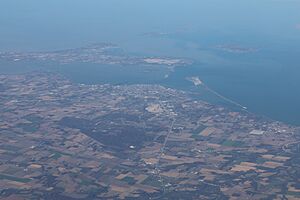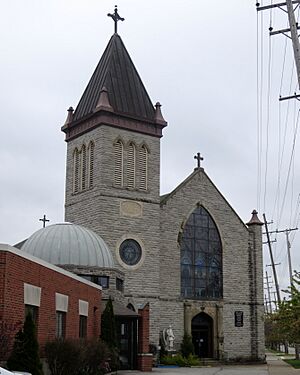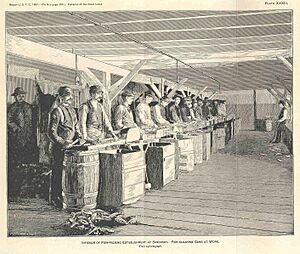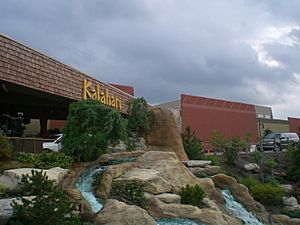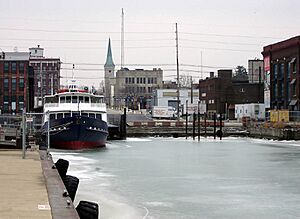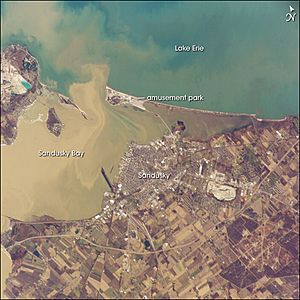Sandusky, Ohio facts for kids
Quick facts for kids
Sandusky, Ohio
|
|||
|---|---|---|---|

Downtown Sandusky
|
|||
|
|||
| Nickname(s):
"Home of Cedar Point"
|
|||
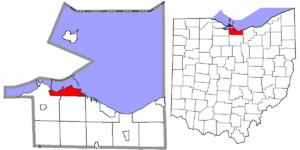
Location of Sandusky in Erie County, Ohio.
|
|||
| Country | |||
| State | |||
| County | Erie | ||
| Founded | 1818 | ||
| Area | |||
| • City | 21.83 sq mi (56.53 km2) | ||
| • Land | 9.63 sq mi (24.96 km2) | ||
| • Water | 12.19 sq mi (31.58 km2) | ||
| Elevation | 584 ft (178 m) | ||
| Population
(2020)
|
|||
| • City | 25,095 | ||
| • Density | 2,604.57/sq mi (1,005.58/km2) | ||
| • Metro | 115,986 | ||
| Time zone | UTC−05:00 (EST) | ||
| • Summer (DST) | UTC−04:00 (EDT) | ||
| ZIP Codes |
44870–44871
|
||
| Area code(s) | 419/567 | ||
| FIPS code | 39-70380 | ||
| GNIS feature ID | 1086070 | ||
Sandusky (pronounced san-DUSS-kee) is a city in Ohio, United States. It is the main city of Erie County, Ohio. Sandusky is located on the southern shore of Lake Erie. It sits about halfway between the cities of Toledo and Cleveland. In 2020, about 25,095 people lived in Sandusky.
Sandusky was founded in the early 1800s. It grew into an important port city on Sandusky Bay. Today, Sandusky is famous for being home to Cedar Point. This is one of the most popular amusement parks in the world. The city also has several water parks. These include Cedar Point Shores, Castaway Bay, Great Wolf Lodge, and Kalahari.
Contents
- What Does the Name Sandusky Mean?
- A Look Back at Sandusky's History
- Where is Sandusky Located?
- Who Lives in Sandusky?
- What is Sandusky's Economy Like?
- Fun Things to Do in Sandusky
- Museums and History in Sandusky
- Learning in Sandusky
- Media in Sandusky
- Getting Around Sandusky
- Famous People from Sandusky
- See also
What Does the Name Sandusky Mean?
The name "Sandusky" comes from the Wyandot language. The Wyandot people were Native Americans who lived in this area. The word saundustee means "water" or andusti, meaning "cold water."
Early French maps from the 1700s show the bay as "Lac Sandouské." The name was used for the Sandusky Bay and the Sandusky River. Over time, several forts and villages were named Sandusky. These included Fort Sandusky and Upper Sandusky.
A Look Back at Sandusky's History
Early Beginnings in the 1700s
The area around Sandusky Bay was a busy place for trading in the 1700s. English, French, and American groups built trading posts and forts here. This showed how important the location was for trade and defense.
Growth and Change in the 1800s
The city of Sandusky began to be settled by European Americans in 1818. It was built on the southeast shore of Sandusky Bay. The city quickly grew to include an older village called Portland. Sandusky officially became a city in 1824.
Sandusky's location on Sandusky Bay was very important for its growth. It became a key spot for moving goods and people. The mild weather near Lake Erie also helped the area become known for its wine. Limestone quarries and ice harvesting were also important industries. Later, lumber transport and manufacturing helped the city's economy.
A Stop on the Underground Railroad
Before slavery was ended in the United States, Sandusky was a safe place for people escaping slavery. It was a stop on the Underground Railroad. Many freedom seekers traveled across Lake Erie to reach Canada. Canada was a place where they could be truly free.
Railroads and City Development
In 1835, work began on the Mad River and Lake Erie Railroad in Sandusky. This railroad brought big changes to the town. Factories and businesses grew near the railway. Goods could be easily moved through the port.
In 1838, Erie County, Ohio was created. Sandusky was chosen as the county seat. This meant it became a center for government in the region. By 1846, Sandusky had about 3,000 people. It was a busy town with stores, banks, churches, and schools.
The famous English writer Charles Dickens visited Sandusky in 1842. He wrote about his visit in his travel book, American Notes.
By 1880, Sandusky's population had grown to 16,000. The city had many businesses making different products. These included railroad cars, carriages, and tools. Sandusky also became a center for making wood wheels.
The 1900s and Beyond

In the early 1900s, paper-making became a big industry in Sandusky. The Hinde & Dauch Paper Company was a major employer.
As the 20th century continued, Sandusky's economy focused more on tourism and fishing. Today, many old industrial areas downtown are being turned into marinas. This is for boats and other water activities. Sandusky has also been named a Tree City USA by the National Arbor Day Foundation.
Where is Sandusky Located?
Sandusky covers about 21.91 square miles (56.75 square kilometers). About 9.73 square miles (25.20 square kilometers) is land. The rest, about 12.18 square miles (31.55 square kilometers), is water. The city is located next to Sandusky Bay and Lake Erie.
Sandusky's Weather
Sandusky has a climate with warm summers and cold winters. This is typical for the Midwestern United States. In January, the average high temperature is about 34°F (1°C). In July, the average high is about 82°F (28°C). The city gets about 16.2 inches (41 cm) of snow each winter. Fall is usually the driest season.
| Climate data for Sandusky, Ohio (1991–2020 normals, extremes 1896–present) | |||||||||||||
|---|---|---|---|---|---|---|---|---|---|---|---|---|---|
| Month | Jan | Feb | Mar | Apr | May | Jun | Jul | Aug | Sep | Oct | Nov | Dec | Year |
| Record high °F (°C) | 73 (23) |
75 (24) |
85 (29) |
90 (32) |
93 (34) |
104 (40) |
105 (41) |
105 (41) |
99 (37) |
93 (34) |
82 (28) |
73 (23) |
105 (41) |
| Mean maximum °F (°C) | 56 (13) |
59 (15) |
68 (20) |
79 (26) |
86 (30) |
92 (33) |
93 (34) |
91 (33) |
88 (31) |
80 (27) |
68 (20) |
59 (15) |
94 (34) |
| Mean daily maximum °F (°C) | 34.4 (1.3) |
37.0 (2.8) |
45.0 (7.2) |
57.3 (14.1) |
68.5 (20.3) |
78.1 (25.6) |
82.3 (27.9) |
80.5 (26.9) |
74.5 (23.6) |
63.0 (17.2) |
50.1 (10.1) |
39.3 (4.1) |
59.2 (15.1) |
| Daily mean °F (°C) | 28.1 (−2.2) |
30.2 (−1.0) |
38.0 (3.3) |
49.3 (9.6) |
60.8 (16.0) |
70.8 (21.6) |
74.7 (23.7) |
73.2 (22.9) |
66.7 (19.3) |
55.3 (12.9) |
43.5 (6.4) |
33.6 (0.9) |
52.0 (11.1) |
| Mean daily minimum °F (°C) | 21.8 (−5.7) |
23.4 (−4.8) |
30.9 (−0.6) |
41.3 (5.2) |
53.2 (11.8) |
63.4 (17.4) |
67.2 (19.6) |
65.8 (18.8) |
58.9 (14.9) |
47.6 (8.7) |
36.8 (2.7) |
27.8 (−2.3) |
44.8 (7.1) |
| Mean minimum °F (°C) | 1 (−17) |
6 (−14) |
14 (−10) |
28 (−2) |
39 (4) |
50 (10) |
58 (14) |
56 (13) |
45 (7) |
33 (1) |
21 (−6) |
10 (−12) |
−3 (−19) |
| Record low °F (°C) | −20 (−29) |
−15 (−26) |
−7 (−22) |
14 (−10) |
30 (−1) |
41 (5) |
41 (5) |
45 (7) |
34 (1) |
22 (−6) |
3 (−16) |
−16 (−27) |
−20 (−29) |
| Average precipitation inches (mm) | 1.90 (48) |
1.77 (45) |
2.56 (65) |
3.76 (96) |
3.25 (83) |
3.67 (93) |
3.55 (90) |
3.02 (77) |
3.07 (78) |
2.72 (69) |
2.64 (67) |
2.12 (54) |
34.03 (864) |
| Average snowfall inches (cm) | 5.4 (14) |
4.1 (10) |
2.7 (6.9) |
0.6 (1.5) |
0.0 (0.0) |
0.0 (0.0) |
0.0 (0.0) |
0.0 (0.0) |
0.0 (0.0) |
0.0 (0.0) |
0.1 (0.25) |
3.3 (8.4) |
16.2 (41) |
| Average precipitation days (≥ 0.01 in) | 10.6 | 10.1 | 12.2 | 13.1 | 13.3 | 12.1 | 9.8 | 9.7 | 10.0 | 11.8 | 11.1 | 11.7 | 135.5 |
| Average snowy days (≥ 0.1 in) | 3.8 | 2.3 | 1.4 | 0.2 | 0.0 | 0.0 | 0.0 | 0.0 | 0.0 | 0.0 | 0.1 | 1.9 | 9.7 |
| Source: NOAA (snow 1981–2010) | |||||||||||||
Understanding "Sandusky" in History
The word "Sandusky" has been used for different places over time. This can sometimes be confusing. Depending on the date, "Sandusky" might refer to:
- Sandusky City: The village or city we know today, starting around 1817.
- Sandusky Bay: The bay itself, known since the 1700s.
- Sandusky River: The river, known since the 1740s.
- Fort Sandusky: Several forts built in the area at different times.
- Lower Sandusky: An area or village that is now the city of Fremont, Ohio.
- Upper Sandusky: A city located upstream on the Sandusky River.
- Upper Sandusky Old Town: A historic village of the Wyandot tribe.
Who Lives in Sandusky?
| Historical population | |||
|---|---|---|---|
| Census | Pop. | %± | |
| 1830 | 593 | — | |
| 1840 | 1,433 | 141.7% | |
| 1850 | 5,087 | 255.0% | |
| 1860 | 8,408 | 65.3% | |
| 1870 | 13,000 | 54.6% | |
| 1880 | 15,838 | 21.8% | |
| 1890 | 18,471 | 16.6% | |
| 1900 | 19,664 | 6.5% | |
| 1910 | 19,989 | 1.7% | |
| 1920 | 22,897 | 14.5% | |
| 1930 | 24,022 | 4.9% | |
| 1940 | 24,874 | 3.5% | |
| 1950 | 29,375 | 18.1% | |
| 1960 | 31,989 | 8.9% | |
| 1970 | 32,674 | 2.1% | |
| 1980 | 31,360 | −4.0% | |
| 1990 | 29,764 | −5.1% | |
| 2000 | 27,844 | −6.5% | |
| 2010 | 25,793 | −7.4% | |
| 2020 | 25,095 | −2.7% | |
| Sources: | |||
In 2010, Sandusky had 25,793 people living there. There were 11,082 households. About 29.4% of households had children under 18. The average age in the city was 38.5 years old.
Most residents identified as White (70.4%). About 22.0% were African American. People of Hispanic or Latino background made up 4.9% of the population.
What is Sandusky's Economy Like?
Sandusky's economy is driven by several industries. Tourism is a very important part. The city also has strong healthcare and manufacturing sectors.
Major Employers in Sandusky
Here are some of the biggest employers in Sandusky:
- Magnum Management Corp. (which includes Cedar Point)
- Firelands Regional Health System (a hospital)
- Ventra Sandusky LLC (manufacturing)
- Sandusky Board of Education (schools)
- Erie County (local government)
Fun Things to Do in Sandusky
Sandusky is a popular place for tourists. It is known for its amazing amusement parks, water parks, and nearby islands.
Cedar Point: America's Roller Coast
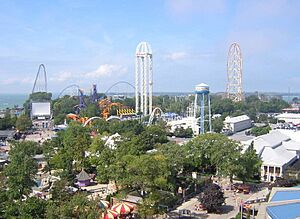
Cedar Point is a huge amusement park on a peninsula in Lake Erie. It is one of the oldest theme parks in the U.S. People often call it "America's Roller Coast." This is because it has 17 roller coasters, one of the largest collections in the world!
Cedar Point is also special because it has six roller coasters that are over 200 feet tall. Many of its roller coasters have set world records. These include Magnum XL-200, Millennium Force, and Top Thrill Dragster.
Splash and Play at Waterparks
Sandusky has several exciting water parks:
- Cedar Point Shores: An outdoor water park next to Cedar Point.
- Castaway Bay: An indoor water park and resort.
- Great Wolf Lodge: Another indoor water park with restaurants and arcades.
- Kalahari Resorts: An African safari-themed indoor water park. It was once the largest of its kind. Its hotel is the biggest in Ohio.
Explore the Nearby Islands
From May to August, many people visit the islands north of Sandusky. You can take a ferry from downtown to reach them. Popular islands include Kelleys Island, South Bass Island (home to Put-in-Bay), Middle Bass Island, and North Bass Island.
The islands and Sandusky often host fun themed parties in the summer. Events like "Island Fest" and "Christmas in July" bring thousands of people together. There's also a "Barge Party" twice a year where boats gather at a sandbar in Sandusky Bay.
Museums and History in Sandusky
Sandusky has several museums and historic homes where you can learn about the past. These include:
- The Cooke-Dorn House: The historic home of Eleutheros Cooke.
- The Follett House Museum: The home of Oran Follett.
- The Maritime Museum of Sandusky: Learn about the area's history with boats and Lake Erie.
- The Merry-Go-Round Museum: A fun museum dedicated to carousels.
- The Ohio Veterans Home Museum: Honors veterans.
Learning in Sandusky
Schools in Sandusky
Sandusky Public Schools serve about 3,775 students. They have six public schools:
- Sandusky Early Learning Academy (Pre-K and Kindergarten)
- Sandusky Primary School (1st and 2nd grade)
- Sandusky Intermediate School (3rd to 6th grade)
- Sandusky Middle School (7th and 8th grade)
- Sandusky High School (9th to 12th grade)
- Sandusky Digital Academy (an online alternative school)
- Sandusky Career Center (vocational programs for adults)
There are also private schools like St. Mary Central Catholic High School. This school offers a faith-centered learning environment. Monroe Prep Academy is another private charter school downtown.
Sandusky Library
The Sandusky Library serves the community. It also has a branch on Kelleys Island.
Media in Sandusky
Newspapers
The city of Sandusky has a daily newspaper called the Sandusky Register. It also covers news for nearby Port Clinton and the Lake Erie Islands.
Television and Radio
Sandusky has one local television station, WGGN-TV channel 52. Because of its location, residents can also receive TV stations from Toledo and Cleveland.
There are 14 local radio stations in the Sandusky area. These stations play different types of music. Some also offer news, sports, or religious programs.
Getting Around Sandusky
Public Transportation
The Sandusky Transit System (STS) provides bus service throughout the Greater Sandusky Area. It has several routes:
- Blue Line: Serves the suburban area, mall, and Kalahari Resort.
- Red Line: Covers the East side and Downtown.
- Yellow Line: Goes to Cedar Point and the Sports Center.
- Orange Line: Serves Midtown.
- Purple Line: Covers the south side.
- Green Line: Serves the west side.
Train and Bus Services
Amtrak, the national passenger train system, has a station in Sandusky. Two trains stop there daily: the Capitol Limited and the Lake Shore Limited. The Sandusky Amtrak Station also has a Greyhound Lines bus station.
Ferry Boats
Several ferry boats connect Sandusky to the nearby islands. They leave from the Jackson Street Pier.
- M/V Goodtime I: Offers daily service to Kelleys Island and South Bass Island.
- M/V Pelee Islander: Provides service to Pelee Island in Canada.
- Jet Express: Offers fast service to Kelleys Island, South Bass Island, and Cedar Point.
Air and Road Travel
For air travel, Sandusky is served by Erie–Ottawa International Airport in nearby Port Clinton. This airport handles smaller planes and flights to the Lake Erie Islands. Larger airports in Detroit, Columbus, and Cleveland also serve the area.
Sandusky is easy to reach by car. It is a short drive from the Ohio Turnpike (Interstate 90 and Interstate 80). U.S. Route 6, Ohio State Route 4, and U.S. Route 250 also run through Sandusky.
Famous People from Sandusky
Many notable people have connections to Sandusky. Here are a few:
- Bill Berry: Drummer for the band R.E.M..
- Brian Bixler: A Major League Baseball player.
- Jay Cooke: A famous financier during the Civil War.
- Jay Crawford: A sportscaster.
- Thom Darden: A defensive back for the Cleveland Browns.
- Jon Gruden: A well-known NFL head coach and TV analyst.
- Scott May: An Olympic gold medalist and NBA basketball player.
- Jackie Mayer: Miss America 1963.
- Orlando Pace: A Pro Football Hall of Fame offensive lineman.
- Kevin Randleman: A former UFC Heavyweight Champion.
- Edmund Ross: A Senator whose vote was important in a presidential impeachment.
See also
 In Spanish: Sandusky (Ohio) para niños
In Spanish: Sandusky (Ohio) para niños







